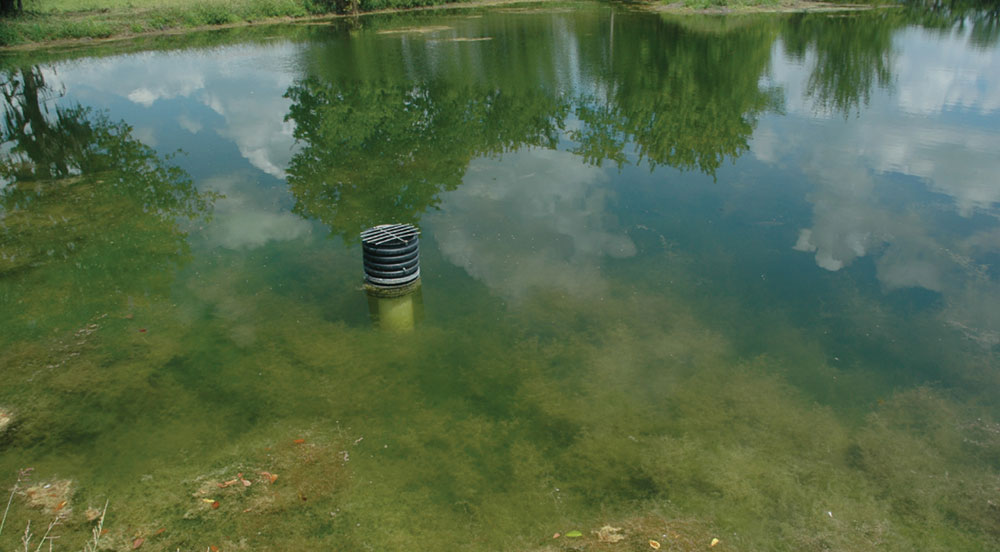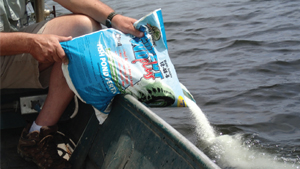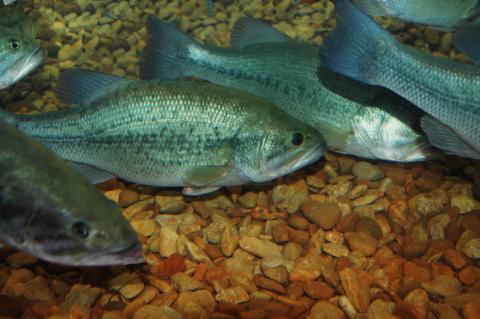Barry Smith
Most GameKeepers are very familiar with fertilizing their food plots; they often have soil tests on their plots to determine if they need to apply agricultural limestone and the types of fertilizer recommended for their particular cultivars. We know if the soils are too acidic the plants are unable to effectively assimilate the fertilizer to provide growth and production for wildlife. Interestingly, many of the same principles apply to your ponds and lakes.
Fertilization of lakes and ponds is not a new idea. One of the earliest evaluations was conducted at Auburn University by Dr. Homer Swingle and his colleagues during the late 1940s. Their research determined that with adequate water quality, fertilization of ponds could triple the total productivity of lakes that were not fertilized. This of course, triples the pounds of sport fish produced, significantly increasing potential catch and harvest.

What is Fertilization of Lakes?
A fertilization program typically starts in the spring when the water temps are greater than 60 F and continues throughout the summer and into the early fall. Fish do not eat the fertilizer but benefit from increasing the productivity of the basic food chain, bacteria, single cell plants (phytoplankton), microscopic animals (zooplankton), insects, small fish and on up to the apex predator, largemouth bass.
Unlike most of your food plots where nitrogen (N) is important, phosphorus is the most important ingredient in the N-P-K mixture for lakes and ponds. It should be in a dissolvable form so that it can benefit the basic food chain. The goal is not to develop larger plant (macrophyte) growth, but to develop single cell plant growth that develops a green color in your lake. Lakes and ponds should be fertilized based on visibility, when the lake clears to a visibility of greater than 24 inches, fertilizer should be re-applied. Do not fertilize entirely on a calendar basis, as fertilizing a heavy plankton bloom in the summer can increase the potential for a fish kill.
Types of Pond Fertilizers
During the 1950s through the early 1970s, inorganic granular fertilizers such as 0-20-20 or 5-20-20 were the standards of lake fertilization. It was discovered early on that broadcasting these granular fertilizers across the pond was an ineffective method of application, as the phosphorus portion of the fertilizer became bound in the bottom mud and would not dissolve. Pouring the fertilizer on an underwater platform, one platform for each five acres, was very effective. Application rates were one 50-pound bag per surface acre. For larger lakes, this entails handling a high poundage of fertilizer.
Established lakes often respond well to a phosphate only fertilizer, such as triple superphosphate at a rate of one 50-pound bag per three acres. The bag can be poured on a platform or with the top side of the bag removed, placed in water 12 to 18 inches deep on a point or shoreline exposed to the wind.
During the 1970s it was discovered that a liquid fertilizer, such a green poly-N (10-34-0) used for corn, worked well in lakes. This was a heavy liquid, weighing almost 13 pounds per gallon and needed to be mixed with water to prevent it from layering on the bottom. The advantages of this liquid was it could be stored in a tank lakeside and gravity flowed into a tank in a boat and siphoned into the lake using a venturi pump attached to the cavitation plate of an outboard motor. For larger lakes, this set up made life much easier.
During the early 2000s, dissolvable powdered fertilizers were developed that made lake and pond fertilization much easier. This fertilizer could be broadcast from the bank and in ponds less than 5 acres could be effectively applied from a single location, requiring only 5 to 7 pounds per surface acre. There are a number of powdered fertilizers ranging in formulations from 10-52-0 to Mossy Oak’s Perfect Pond Plus that is a 12-48-8, and containing a micronutrient package that benefits plankton production in many ponds. The potassium nitrate in Perfect Pond Plus dissolves as it enters the water making it a more effective fertilizer. Other brands use a different form of potassium that is not as soluble and can end up on the pond bottom. Perfect Pond fertilizer dissolves in the upper two feet of the water column and for larger lakes, can be effectively applied by pouring over the side of a moving boat.
Should all Lakes be Fertilized?
 Many lakes in the Midwest and Southwest, built on soils that have high mineral content, the same soils that produce big-racked bucks, do not benefit as much from fertilizer as in other areas of the United States. Fish production in many of these fertile soils are high enough to sustain good fisheries without fertilization.
Many lakes in the Midwest and Southwest, built on soils that have high mineral content, the same soils that produce big-racked bucks, do not benefit as much from fertilizer as in other areas of the United States. Fish production in many of these fertile soils are high enough to sustain good fisheries without fertilization.
Lakes with a high watershed ratio that have constant flow throughout the summer are not good candidates for a fertilization program. The water exchange is often so high that the phytoplankton produced by fertilization leaves the lake at a rapid rate, making the attempt to fertilize ineffective. Extremely clear, acidic lakes, with a pH of 5 or below can’t be effectively fertilized unless it is treated with large quantities of agricultural lime-stone to neutralize the acidity of the lake bottom.
Larger lakes with very low fishing pressure and/or harvest do not benefit from a fertilization program. Increasing production often requires harvest levels that cannot be reasonably achieved by only a few anglers.
Do not fertilize your lake, regardless of size, if it has an infestation of aquatic weeds or algae. Contrary to popular belief, pond fertilizer does not kill weeds or algae. The theory is to fertilize your lake, develop a plankton bloom of 18 to 24 inches and shade the bottom to retard the development of weeds. However, once the weeds are established, fertilizer makes them grow at a rapid rate. Consult with a certified aquatic applicator to treat the weed infestation with an approved herbicide before beginning a fertilization program.
Do not fertilize your lake or pond in the summer if the bloom is less than 24 inches. Very heavy plankton blooms increase the probability of creating an oxygen-related fish kill. Heavy plank-ton blooms respire heavily at night and may use all of the avail-able oxygen resulting in death of the plankton and rapid decay. These conditions can produce an almost total fish kill.
Fertilization can be a good tool for increasing growth and production of game fish, helping make your own lake a “honey hole” for anglers. Follow the recommendations above and use common sense to develop a healthy lake and a great fishery!




























